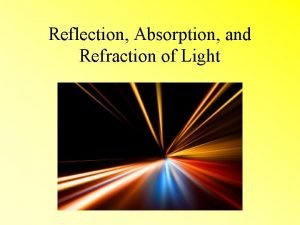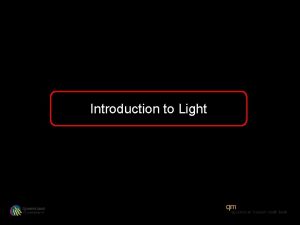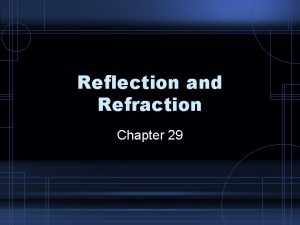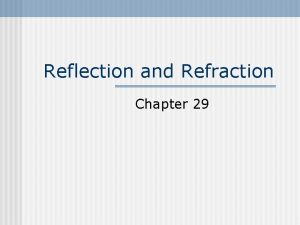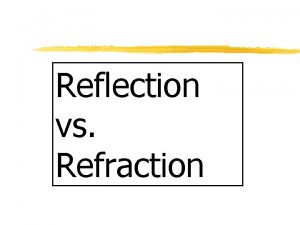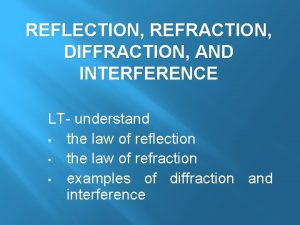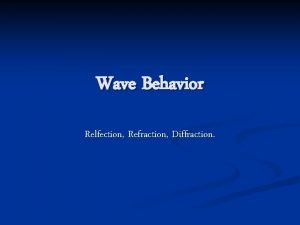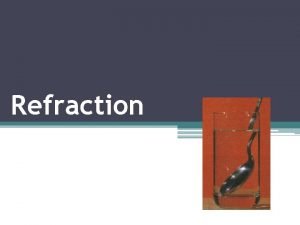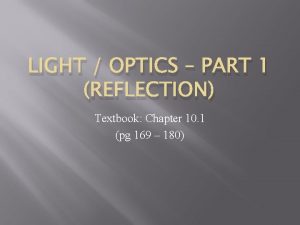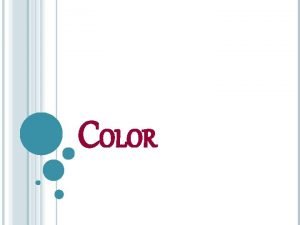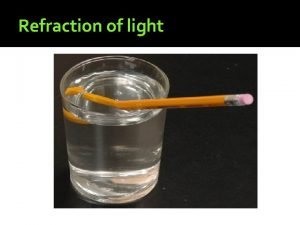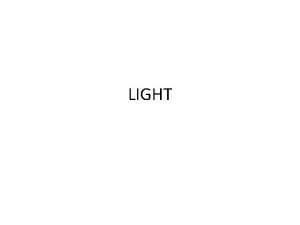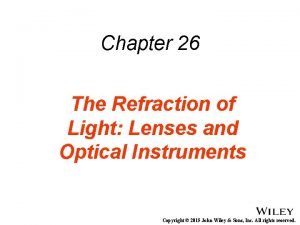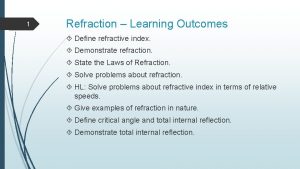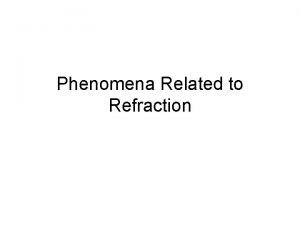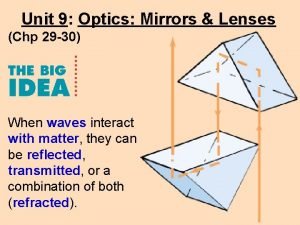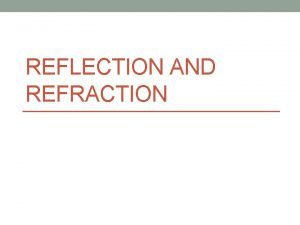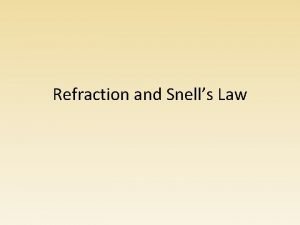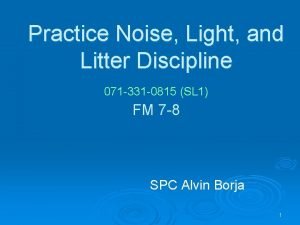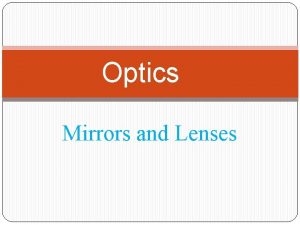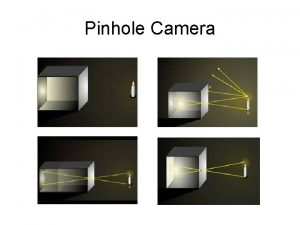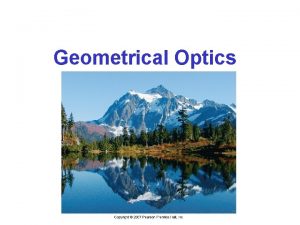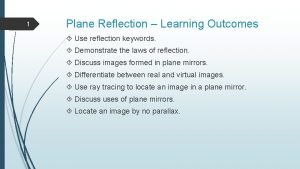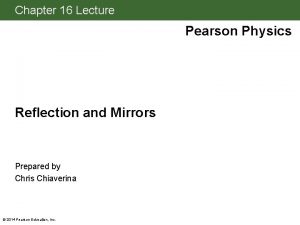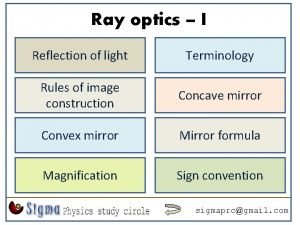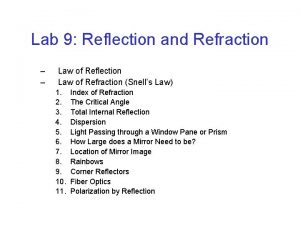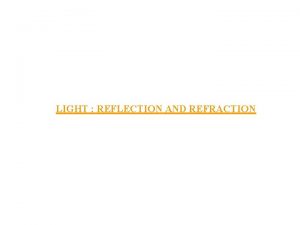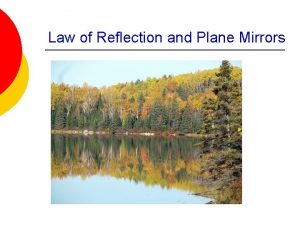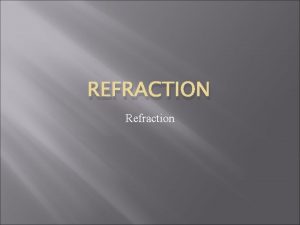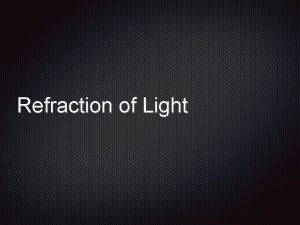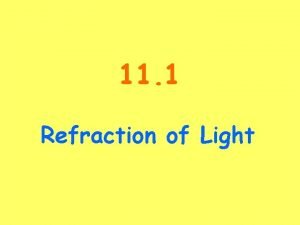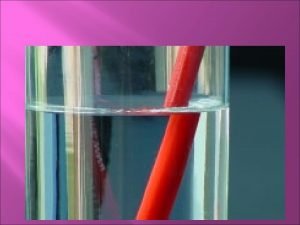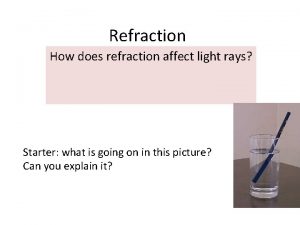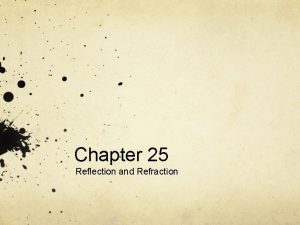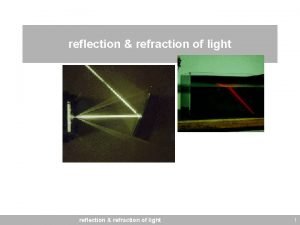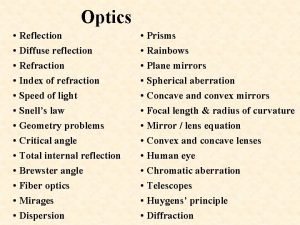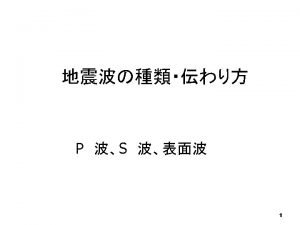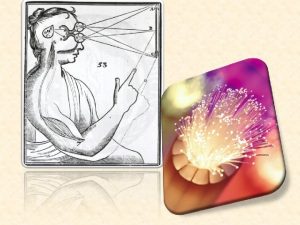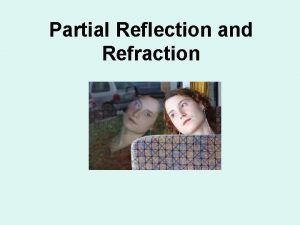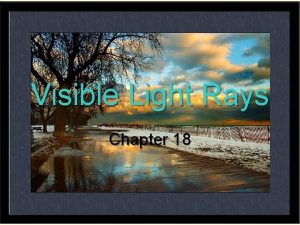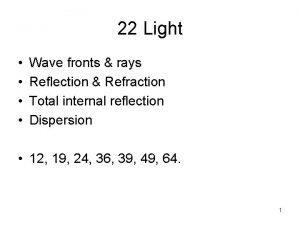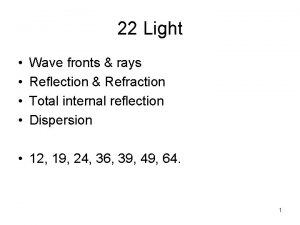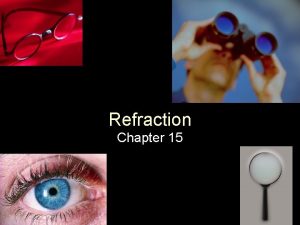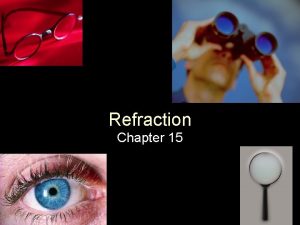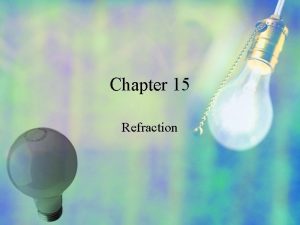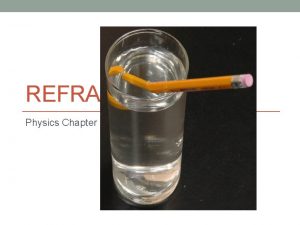Chapter 17 Reflection Refraction Reflection When light rays

















































- Slides: 49

Chapter 17 Reflection & Refraction

Reflection • When light rays bounce back off of a medium boundary

Refraction • The bending of light rays when passing from one medium to another

Ray • A straight line path representing the direction of a light wave

Specular Reflection • Reflection off of a smooth surface which results in reflected wave that are parallel

Specular Reflection • Produce good images • Mirrors give regular reflections

Diffuse Reflection • Reflection off of a rough surface which results in reflected waves that are not parallel

Diffuse Reflection • Because light waves are scattered all over the place, no image can be seen

Law of Reflection • The angle of reflection equals the angle of incidence

Law of Reflection a b b = a Normal

Optical Density • How fast light passes through a substance as compared to the speed of light in a vacuum.

Optical Density • As optical density increases, the speed in which light passes decreases

Index of Refraction (n) • Ratio of the speed of light in a vacuum to the speed of light in a material

Indices of Refraction • Vacuum: n = 1. 00 • Air: n = 1. 0003 • Water: n = 1. 33 • Ethanol: n = 1. 36

Indices of Refraction • Crown glass: n = 1. 52 • Quartz: n = 1. 54 • Flint glass: n = 1. 61 • Diamond: n = 2. 42

Speed of Light in Other Substances nsub = c vsub

Speed of Light in Other Substances vsub = c nsub

Solve for the speed of light in each of the following: water (n = 1. 33) crown glass (n = 1. 52) diamond (n = 2. 42)

Solve for the speed of light in a substance with an optical density of 1. 50:

Snell’s Law • The ratio of the sine of the angle of incidence over the sine of the angle of refraction is constant for any substance

Snell’s Law n = sin ai sin ar

Snell’s Law ni sin ai = nr sin ar

Snell’s Law ai n 1 = air ar n 2 = water

Draw a model with a light ray passing from one medium to another more optically dense medium. Include reflection & refraction

A light ray from air (nair = 1. 00) strikes glass (nglass = 1. 52) with an o incident angle of 30. 0. Calculate the angle of refraction:

A light ray from air (nair = 1. 00) strikes glass (nglass = 1. 61) with an o incident angle of 36. 9. Calculate the angle of refraction:

A light ray from air (nair = 1. 00) & strikes diamond (ndiamd = 2. 42) with an incident angle o of 45. 0. Calculate the angle of refraction:

A light ray incident from air (nair = 1. 00) at o 45. 0 passes into an unknown substance at o 30. 0. Calculate its index of refraction:

Total Internal Reflection • When light passes from a more optically dense substance to a less optically dense one, the angle of refraction > the angle of incident

b a

Total Internal Reflection (TIR) • When the angle of o refraction 90 , total internal reflection occurs.

Calculate the angles where TIR occurs when light passes from the following to air: water (n = 1. 33) crown glass (n = 1. 52) diamond (n = 2. 42)

Applications & Effects • Prisms • Fiber Optics • Mirages • Red Sunsets • Rainbows

Prisms • When light pass through a prism the various wavelengths of light are dispersed or separated into a spectrum

Prisms

Fiber Optics • A light wave can pass through a thin glass thread surrounded by a reflective substance. Even if the glass thread is bent, the wave passes through as it reflects off the sides.

Mirages • Light refracted from a far away source looks closer

Mirages

Sunsets & Rises • Sunlight is refracted as it strikes the atmosphere at great angles bending light towards Earth

Sunsets • Because different wavelengths are refracted differently, colors change

Sunsets

Rainbows • Sunlight is refracted & reflected by rain droplets dispersing the light into a spectrum

Rainbows

Rainbows fall o from 40 – 42 from incident

Rainbows fall o from 40 – 42 from incident

A light ray from water (nw = 1. 33) & strikes diamond (ndiamd = 2. 42) with an incident angle o of 53. 0. Calculate the angle of refraction:

A light ray from water (nw = 1. 33) & strikes glass (nglass = 1. 51) with an incident angle of o 53. 0. Calculate the angle of refraction:

Calculate the angle of total internal reflection of pukon with n = 3. 00

An incident ray from air strikes quartz (n = 1. 50) at an angle of o 30 from normal. Calculate: refl & refr
 Reflection refraction absorption
Reflection refraction absorption Introduction of light reflection and refraction
Introduction of light reflection and refraction Chapter 29 reflection and refraction
Chapter 29 reflection and refraction Refraction of sound
Refraction of sound Light light light chapter 23
Light light light chapter 23 Into the light chapter 22
Into the light chapter 22 Light light light chapter 22
Light light light chapter 22 Refraction vs reflection
Refraction vs reflection Reflection refraction diffraction interference
Reflection refraction diffraction interference Cmedium
Cmedium Reflection refraction diffraction
Reflection refraction diffraction Poetry reaction
Poetry reaction Refraction examples
Refraction examples Bill nye reflection and refraction
Bill nye reflection and refraction Invictus ernest hemingway
Invictus ernest hemingway Bill nye reflection and refraction
Bill nye reflection and refraction Reflection refraction
Reflection refraction Reflection and refraction venn diagram
Reflection and refraction venn diagram Venn diagram of series circuit and parallel circuit
Venn diagram of series circuit and parallel circuit Bill nye reflection and refraction
Bill nye reflection and refraction Learning task 1 reflection and refraction
Learning task 1 reflection and refraction Things that can block light
Things that can block light Colorter
Colorter Lateral displacement formula
Lateral displacement formula Concave vs convex light refraction
Concave vs convex light refraction Refraction of light in lenses
Refraction of light in lenses Learning objectives of refraction of light
Learning objectives of refraction of light Refraction phenomena
Refraction phenomena Refraction of light
Refraction of light When a wave reaches a boundary it
When a wave reaches a boundary it Refraction of light
Refraction of light Refraction
Refraction Discipline of light refraction
Discipline of light refraction Diverging lens negative focal length
Diverging lens negative focal length Reflection at plane surfaces
Reflection at plane surfaces Reflection light analogy
Reflection light analogy Light strikes
Light strikes Light reflection
Light reflection Plane mirror used
Plane mirror used Reflection of light
Reflection of light Reflection of light example
Reflection of light example Salt and light reflection
Salt and light reflection Mirror formula derivation
Mirror formula derivation Laws of refraction
Laws of refraction Lens sign convention
Lens sign convention Characteristics of reflection of light
Characteristics of reflection of light Point of incidence
Point of incidence Put out the light
Put out the light Bacteria double membrane
Bacteria double membrane The bouncing off of light.
The bouncing off of light.
